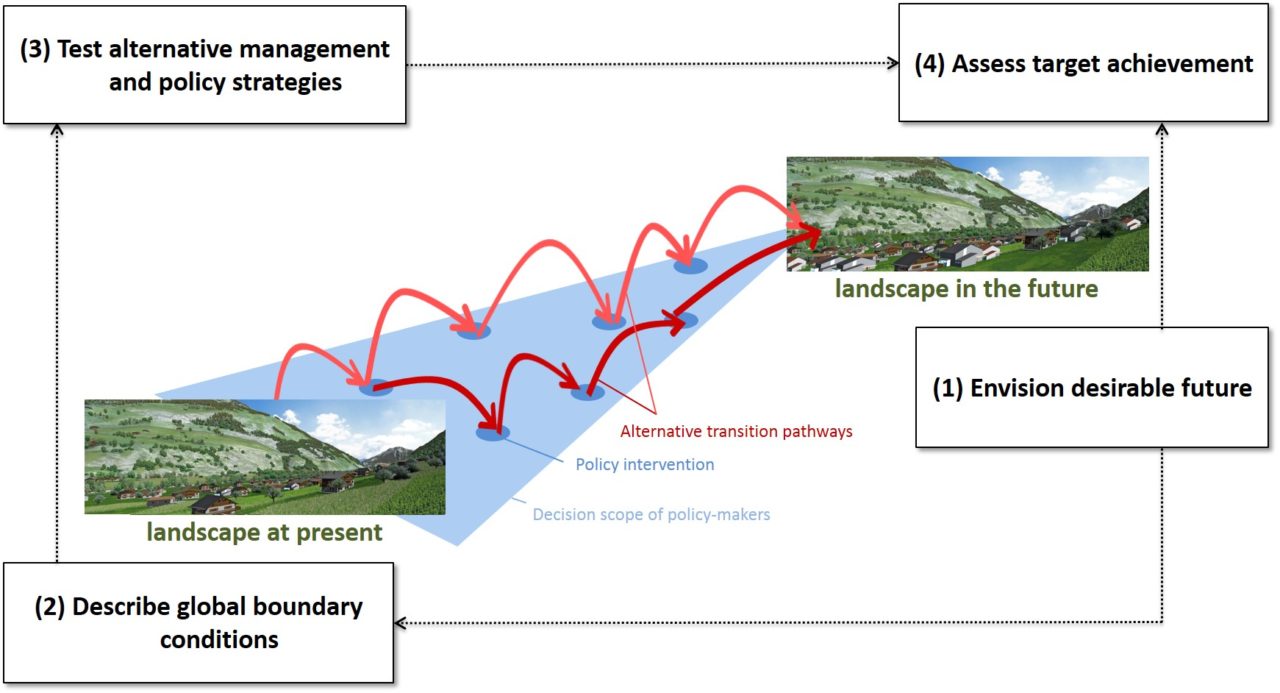
Backcasting is a planning method that identifies a desired future and then evaluates how this desired state can be reached. But how would this desired future look like? Searching for ideas and visions promotes creative solutions and stimulates discussions.
We are familiar with forecasting methods that project different pathways resulting in different future outcomes. Forecasts provide different options of future conditions often characterized by a certain probability. Weather forecasts for example evaluate different probabilities about weather conditions in the near future. From a planning perspective however, we would like to know how to reach one specific desired future state. What kind of management strategies or regulations are required? How should we act today to reach the desired future? Answering these questions is crucial for decision-making today yet it is very challenging to evaluate the effect of interventions.
In the transdisciplinary research project «Mountland» running for more than nine years, the PLUS chair evaluated which policy measures had to be implemented at what point in time to effectively maintain the cultural landscape in a Swiss mountain region (Figure 1). First of all, the desired future state was assessed with choice experiments in which people were asked to rank visualizations of mountain landscapes. Thus, the preferences for alternative future landscapes were determined. Then, several policy measures including a more restrictive spatial planning policy or a change in the agricultural policy were evaluated.
Effects of Direct Payments Level off
Results show how, when and where to best intervene the system to reach a desired target: An increase in direct payments for mountain agriculture for example helps to reach the desired future state within few years after implementation, but the effect levels off after the implementation period. Thus, this is a useful strategy if rapid adaption is required but its urgency is not very pronounced. By contrast, early spatial planning interventions are more effective than later ones, i.e. the later the policy is implemented, the bigger the gap between the realized and the desired future state.
The study also reveals effects of the combination of interventions as opposed to single interventions highlighting trade-offs and synergies between policy measures. Results indicate that a set of interventions is more likely to reach the desired future than single interventions. These combined interventions seem to be more robust to global change. Changes in the boundary conditions have however a major effect on how close we might come to the desired future state and these changes are very difficult to predict. But no matter which intervention is finally applied, the gap between the reached and the desired future state remains largest if no policy action is taken at all.
Sibyl Hanna Brunner and Bettina Weibel are scientific assistants at the chair of Prof. Dr. Adrienne Grêt-Regamey: Planning of Landscape and Urban Systems (PLUS)
Image: Backcasting approach applied in the MOUNTLAND project to evaluate the effectiveness of policy measures to maintain the cultural landscape.
Brunner, Sibyl Hanna; Huber, Robert; Grêt-Regamey, Adrienne (2016): A backcasting approach for matching regional ecosystem services supply and demand. Environmental Modelling & Software 75. S.439-458.
Brunner, Sibyl Hanna; Grêt-Regamey, Adrienne (2016): Policy strategies to foster the resilience of mountain social-ecological systems under uncertain global change. Environmental Science & Policy. Oxford: Elsevier Science.
Brunner, Sibyl Hanna; Grêt-Regamey, Adrienne; Huber, Robert (2017): Mapping uncertainties in the future provision of ecosystem services in a mountain region in Switzerland. In: Regional environmental change.